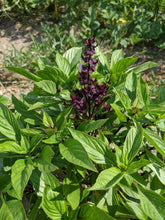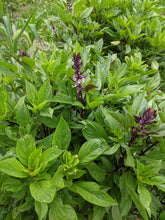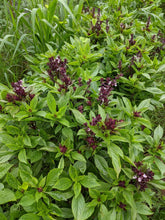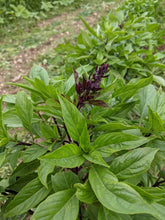'Dire Dawa' Basil
Regular price
$4.00
Sale
Ocimum spp.
Origin: Dire Dawa, Ethiopia
Improvement status: Cultivar
Seeds per packet: ~75
Germination tested 12/2025: 50%
Life cycle: Annual
EFN INTRODUCTION. We've grown (or otherwise encountered) many basils through the years — various Italian basils, tulsi basils, other African basils, Southeast Asian basils, hoary basils — but we've never smelled, tasted, or seen anything quite like this one. It's something else entirely. Collected by USDA plant explorer William Andrew Archer in 1951, this basil comes from Dire Dawa in eastern Ethiopia, a predominantly Oromo and Somali city located not far from the Somali border. We got it from the USDA's North Central Regional Plant Introduction Station in Ames, Iowa.
Frankly, we're not even sure what species this basil is — though the USDA records it as Ocimum basilicum (the same species as common Genovese basil). We think there's a chance it might be of hybrid origin, possibly with some clove basil (Ocimum gratissimum) or the Ethiopian tulsi called besobela (Ocimum tenuiflorum) in its lineage. The purple stems and flower spikes mark this variety as unusual from the get-go (some clove basils have green leaves and purple stems), but it's the aroma and flavor that really sets it apart. It has some of the classic basil smell, but there's also something else going on. It's stronger, perhaps a bit more minty, maybe borderline fennel-like, and definitely spicier than your average basil. Unfortunately, it's really hard to describe, so you'll just have to take my word for it that it's extraordinarily delicious (though one visitor to the farm thought it was too strong). It made a pesto (with macadamia nuts, garlic, parmesan cheese, and unfiltered olive oil) that knocked my socks off.
The USDA notes that this basil was used as a parent plant in the breeding of the cultivar 'Maria Bonita,' and that its essential oil has "antinociceptive" (reduces pain sensation) and "antigiardial" (kills the parasitic microorganism that causes giardia sickness) properties. It hasn't been studied very much, so there's a good chance it has other medicinal uses as well.
We hope this fascinating basil starts making the rounds and someone out there can tell us more about it!
Nate grew this year's crop at our flagship research farm in Elmer, NJ.
GROWING TIPS: Grow as you would any other basil. Surface sow or plant just beneath surface. Plants start out quite small, so best to start these in flats.








